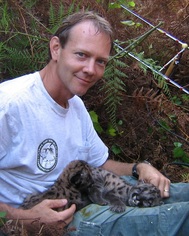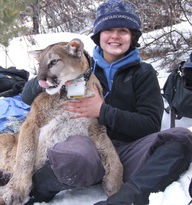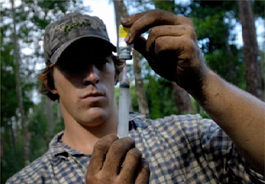Presentations
10:30 - The Panthers of Big Cypress
Each panther that has been radio-collared in Big Cypress National Preserve has a unique life history. You can get to know some of these rare cats, as Annette shares interesting details of their lives while showing the beautiful photography of Ralph Arwood.
Each panther that has been radio-collared in Big Cypress National Preserve has a unique life history. You can get to know some of these rare cats, as Annette shares interesting details of their lives while showing the beautiful photography of Ralph Arwood.
Presented by:
|
Annette Johnson
Since 2003, Annette Johnson has been involved with the conservation and management of a variety of animal species within Big Cypress National Preserve. As a member of the Big Cypress National Preserve Florida Panther Capture Team, she is involved with the safe capture, handling and monitoring of adult panthers and the medical workup of panther kittens at den sites.
|
11:30 - Test Your Florida Panther IQ
Experience an interactive, humorous learning activity that will teach you all about Florida panthers. The activity will feature a multiple choice test format. It will delve into Florida panther facts such as their basic life history, myths and rumors and frequently asked questions about panthers.
Experience an interactive, humorous learning activity that will teach you all about Florida panthers. The activity will feature a multiple choice test format. It will delve into Florida panther facts such as their basic life history, myths and rumors and frequently asked questions about panthers.
1:00 - CSI: Panther Edition
As the Florida panther population increases, interactions between humans and panthers are becoming more frequent. In recent years, ranchers have reported that calf depredation by predators, specifically by the Florida panther, has been increasing. Ranches provide important habitat for the Florida panther and therefore ranchers’ acceptance and support is critical to the successful recovery of the Florida panther. To examine the issue of calf depredation more closely, we have designed a study to quantify calf mortality caused by the Florida panther. To do this we are tagging calves with ear tag transmitters so that all calf mortalities can be documented and evaluated for cause of death. If the cause of death is predation, the predator responsible is identified. To date we have confirmed that panthers of both sexes have killed calves and that one panther has killed more than one calf. The second year of the study began September 2012 and the research is being conducted on two ranches in southwest Florida.
As the Florida panther population increases, interactions between humans and panthers are becoming more frequent. In recent years, ranchers have reported that calf depredation by predators, specifically by the Florida panther, has been increasing. Ranches provide important habitat for the Florida panther and therefore ranchers’ acceptance and support is critical to the successful recovery of the Florida panther. To examine the issue of calf depredation more closely, we have designed a study to quantify calf mortality caused by the Florida panther. To do this we are tagging calves with ear tag transmitters so that all calf mortalities can be documented and evaluated for cause of death. If the cause of death is predation, the predator responsible is identified. To date we have confirmed that panthers of both sexes have killed calves and that one panther has killed more than one calf. The second year of the study began September 2012 and the research is being conducted on two ranches in southwest Florida.
2:00 - Florida Wildlife Corridor Expedition
Earlier this year biologist Joe Guthrie, conservationist Mallory Lykes Dimmitt, filmmaker Elam Stoltzfus and photojournalist Carlton Ward Jr. trekked 1,000 miles in 100 days from Everglades National Park, Florida to Okefenokee National Wildlife Refuge in southern Georgia. The group traversed the wildlife habitats, watersheds and participating working farms and ranches, which comprise the Florida Wildlife Corridor opportunityarea. The team documented the corridor through photography, video streams, radio reports, daily updates on social media and digital networks,and a host of activities for reporters, landowners, celebrities, conservationists, politicians and other guests. Come experience an exciting presentation about their unprecedented expedition by Joe Guthrie. He'll show what they saw and give insightful details about their expedition, especially as it related to Florida panthers.
Earlier this year biologist Joe Guthrie, conservationist Mallory Lykes Dimmitt, filmmaker Elam Stoltzfus and photojournalist Carlton Ward Jr. trekked 1,000 miles in 100 days from Everglades National Park, Florida to Okefenokee National Wildlife Refuge in southern Georgia. The group traversed the wildlife habitats, watersheds and participating working farms and ranches, which comprise the Florida Wildlife Corridor opportunityarea. The team documented the corridor through photography, video streams, radio reports, daily updates on social media and digital networks,and a host of activities for reporters, landowners, celebrities, conservationists, politicians and other guests. Come experience an exciting presentation about their unprecedented expedition by Joe Guthrie. He'll show what they saw and give insightful details about their expedition, especially as it related to Florida panthers.




